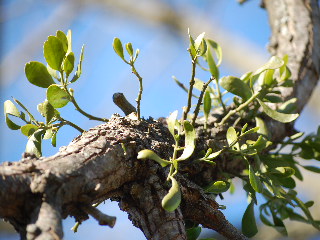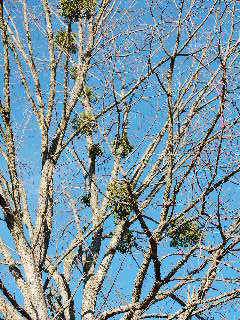
Semi-parasitic plants in the genus Phoradendron, mistletoe clusters owe most of their fame and notoriety to their association with the Christian holiday of Christmas.
But in the grand scheme of Nature, mistletoe is a fascinating plant to study when one looks at the interconnected relationships of plants and animals in the wild.
Here’s how it works. Mistletoe bears fruit in the form of small whitish berries. Birds gain sustenance from incorporating these berries into their diet. In the process of eating the berries, some of the sticky squishy fruit containing the seeds is left on the tree limbs.
Also, some of the seeds pass through the digestive systems of the birds and are excreted onto tree limbs both near and far. The seeds then germinate, sending their parasitic roots down into the limbs of the trees. In this way, the cycle of life, regeneration, and expansion of range for the mistletoe continues.
To me, the most interesting part in the life cycle of mistletoe is the symbiotic relationship between birds and plants—birds get fed, seeds get distributed.
Along these lines, here’s a funny note. The word “mistletoe” comes from 2 Anglo-Saxon words, mistel which means “dung” and tan which means “twig”—therefore, dung on twig equals new life for the mistletoe!
We say that mistletoe is semi-parasitic because, even though it does gain moisture and some nutrients from its host tree, the chlorophyll-containing mistletoe leaves also do carry out the food-making process of photosynthesis as other non-parasitic plants do.
Much of the history of mistletoe comes from folklore and mythology.
The plant is said to ward off evil spirits and to bring good luck, love, and friendship. No wonder it has been harvested, brought into the home, and displayed in various ways and in different cultures throughout the years!

The kissing custom associated with mistletoe appears to have come from England. It is believed that each berry on the displayed cluster of mistletoe was good for one kiss—pick one berry and get one kiss. When all the berries were picked off, no more kisses. Makes you wonder if some of the more amorous households didn’t have extra displays of mistletoe to put into place as the berries got picked away!
Mistletoe is said to have some medicinal applications and to be useful in some herbal remedies, although I am not personally familiar with any of these nor could I find verifiable evidence of healing qualities of the plant in my research.
Again, I think maybe some of the attributes of fertility, good health, and elimination of evil spirits may be rooted in folklore and legend. And I can see where the promise of fertility and the custom of kissing could have evolved together.
It does appear that the ingestion of mistletoe by your household pets does lead to gastrointestinal problems for them, causing diarrhea, vomiting, or death. In other words, don’t let your dogs and cats eat the mistletoe!
The photos on this page were taken in middle Tennessee in late December. Note how the attachment of the parasitic mistletoe to the leafless limbs of the deciduous tree is clearly visible.
Wikipedia was used as a reference for some of the information on this page.
 Semi-parasitic plants in the genus Phoradendron, mistletoe clusters owe most of their fame and notoriety to their association with the Christian holiday of Christmas.
Semi-parasitic plants in the genus Phoradendron, mistletoe clusters owe most of their fame and notoriety to their association with the Christian holiday of Christmas.
 The kissing custom associated with mistletoe appears to have come from England. It is believed that each berry on the displayed cluster of mistletoe was good for one kiss—pick one berry and get one kiss. When all the berries were picked off, no more kisses. Makes you wonder if some of the more amorous households didn’t have extra displays of mistletoe to put into place as the berries got picked away!
The kissing custom associated with mistletoe appears to have come from England. It is believed that each berry on the displayed cluster of mistletoe was good for one kiss—pick one berry and get one kiss. When all the berries were picked off, no more kisses. Makes you wonder if some of the more amorous households didn’t have extra displays of mistletoe to put into place as the berries got picked away!